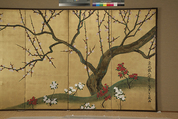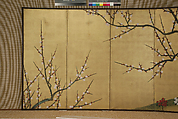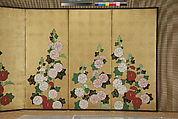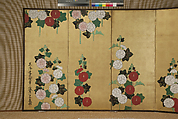Returned to lender The Met accepts temporary loans of art both for short-term exhibitions and for long-term display in its galleries.
Plum Tree and Hollyhocks
Ogata Kenzan Japanese
Not on view
This screen and its mate, displayed in a case on the opposite wall, were inspired by a two-panel screen of the same subject by his brother Ogata Kŏrin (1658–1716). On the right screen here, Kenzan depicted the spring flowers camellia and plum. On the left screen, across the gallery, he spread hollyhocks over the entire surface, introducing an additional group of flowers at the upper left. The composition is rigidly two dimensional and the flowers are seen frontally, but when the screens are made to stand, the flowers and plants come alive in the shifting light reflected against the shining gold background.
Kenzan is said to have been the antithesis of his older, more famous brother Kŏrin. In contrast to Kŏrin’s extroverted personality, Kenzan is said to have been a quiet, scholarly person who liked to read and study Zen. Yet Kŏrin’s influence on Kenzan’s work persisted throughout his career, and is especially noticeable in his ravishingly prismatic designs.
At age sixty-nine, Kenzan abandoned his home in Kyoto and moved to Edo (Tokyo), perhaps in search of more affluent patrons. There, he seems to have gained a reputation as a painter; in fact, most of his paintings are dated to his Edo period. Kenzan painted these screens a few months before his death. He seems to have regarded his move to Edo as a self-imposed exile, as he signed his name “Kyŏchŏ Sanjin” (A Vagabond from Kyoto), perhaps with a hint of nostalgia and self-mockery.
Due to rights restrictions, this image cannot be enlarged, viewed at full screen, or downloaded.
This artwork is meant to be viewed from right to left. Scroll left to view more.





